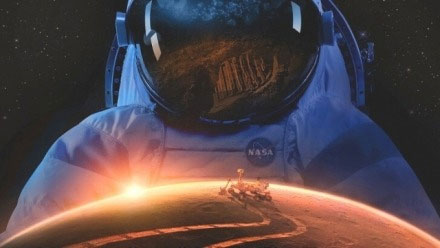|
한국연구재단의 인문사회-창의도전 연구프로잭(3년)을 진행중인 영국 왕립역사학회(The Royal Historical Society, United Kingdom) 석학회원인 교양대학 데이비드 윌리엄 김(David William Kim)교수는 이번에 미국항공우주국이 2033년에 예정인 Mars우주선 계획의 핵심인 장기우주인 (Long-term Astronauts) 연구분야에서 한국에서는 최초로 우주의학 (Space Medicine)이 해결하지 못하는 영역에서 우주과학과 인문학 융합 관념에서 그의 창의적이고 다국적연구팀의 비판적이고 논리적인 가설적 주제 연구결과가 세계적인 학자들 가운데서 인정받아 유럽의 SCIE 저어널 (Aerospace)에 출판하게 되었다.
아래 원문은 비공개 프로잭 (Mars Space Exploration and Astronautical Religion in Human Research History: Psychological Countermeasures of Long-term Astronauts)의 일부 내용을 간단히 소개하고 있다:

Asso. Prof. Dr. David William Kim
The last two decades (2000–2022) witnessed many international organisations poised to launch orbital and landed missions to Mars, the Red Planet (35 million miles from Earth). Eight nations have attempted the experimental investigation and analysis of the Martian environment a total of 55 times. The National Aeronautics and Space Administration (NASA) sent various orbiters, including the Mars Global Surveyor (MGS, 1996), the 2001 Mars Odyssey, the Mars Reconnaissance Orbiter (MRO, 2005), and the Mars Atmosphere and Volatile Evolution (MAVEN, 2013). The European Space Agency (ESA) sent the Mars Express (2003) and the ExoMars Trace Gas Orbiter (TGO or ExoMars Orbiter, 2016). The Mangalyaan project (or Mars Orbiter Mission: MOM) was also designed by the Indian Space Research Organisation (ISRO) in 2014. The Phoenix (2008), an uncrewed space probe, landed on the surface of Mars in 2008, followed by the robotic lander called the InSight (The Interior Exploration using Seismic Investigations, Geodesy and Heat Transport, 2018) to explore the deep interior of the planet Mars.
The efforts of Mars Rover projects, like Mars Exploration Rovers (Spirit and Opportunity; NASA), Mars Science Laboratory (Curiosity; NASA), and ExoMars Rovers (or Rosalind Franklin, ESA), provided scientific sources for Martian research. NASA’s Mars 2020 mission’s Perseverance (Percy), a car-sized Mars rover, landed on Mars on 18 February 2021. Notably, Ingenuity, a solar-charged battery-powered coaxial drone rotorcraft, has advanced technology and capability to scout locations of interest for the first arrival of the Martian version of ‘Neil Armstrong’ as well as its colonial settlement project.

Why Mars? Mars is more hospitable for humans than Venus or Mercury. The Martian day is 24 h and 40 min. The average temperature on Mars ranges from −140° to 30 °C, while Earth ranges from −88° to 58 °C. The evidence of plentiful CO2, which is related to the possibility of growing plants, is harmonised ‘with a dense gaseous atmosphere and liquid (water and ice) oceans’. Buchanan here argues that Martian methane (CH4) and oxygen (O2) can be used as fuel sources. Nevertheless, the critical issues of radiation, altered gravity, hostile environments, isolation or confinement, as well as the distance from Earth (travel time) are the five major hazards for astronauts during space flight. The prepared technology of space medicine that could test psychological troubles and psychiatric symptoms of astronauts would be significant for physical health. However, the problems and mental impairments caused by living on a limited spaceship cannot be perfectly solved by space medical science to support healthy community skills between colleagues in a restricted space for a long time of two to three years (space travel period). Given these limitations, what would be an alternative mental illness prevention strategy to sustain positive human vigorous during the arduous Martian trip?

There are no answers for many other perspectives relating to the dynamic environment of the space community, such as mental fears, uncertainty, anxiety from being in isolation or confinement, distance from Earth (lone travel time), and hostile environments. For example, stressors arising from a confined environment can relate to interpersonal distance, territoriality, and privacy. The increase in these stressors often violates the fundamental need to control the space community in emergencies. A confined space team has lower motivation levels, which are directly connected to a poor ability to perform planned activities. The monotonous pattern worsens human mental sustainability in space, leading to symptoms like boredom, loss of energy, concentration, distracting thoughts, and interpersonal friction. The ‘asthenia’ syndrome, which was first discussed by Soviet psychiatrists in the 1990s, may result from reduced stimulation levels during long monotonous travel time in space.
This research argues that religious behaviours used to be considered an irritating superstition in developing space science, but the experimental data of psychology, sociology, human interactions, and health research strongly prove the mental benefits of prosocial religion. Religion is unique in that it exists in a moral and ethical context where the metaphysical conscience can enhance the prosocial behaviour of each member for the common purpose of a space community. For instance, what kind of crew would more willingly self-sacrifice in dangerous space operations? Joshua Hordern (2011) argues that individuals’ religious cultures connected to their consciences are a potential source of moral conduction in human communication. The scholar presumes that group members can follow a set project or planned procedure in a normal situation. However, in an emergency, sacrificial volunteerism or solicitude is required for others or the technical success of the Mars project. Religious practices correlate with an advanced rate of committed care for other people (One can oppose this view, as it is a very one-sided view of religion). Fear and selfishness can arise in timeless or dangerous situations, but members’ religious attitudes could altruistically solve the critical issue in the spirit of self-sacrifice (Of course, others can also argue that self-sacrifice and altruistic behaviour do not require religion).
For more details, please see https://www.mdpi.com/2226-4310/9/12/814
|











